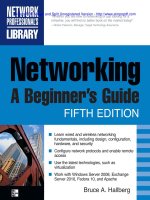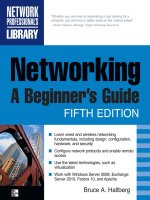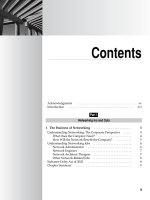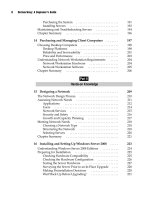Networking: A Beginner’s Guide Fifth Edition- P29 pdf
Bạn đang xem bản rút gọn của tài liệu. Xem và tải ngay bản đầy đủ của tài liệu tại đây (1.13 MB, 5 trang )
122
Networking: A Beginner’s Guide
I
n the preceding chapters, you learned about networking systems together through
a local area network (LAN) and through a wide area network (WAN), and about
the technologies that go into both types of networks. You also need to know about
another important type of network connection: remote access to a network. With
today’s travel-happy corporate cultures, and with companies needing to support such
things as working from home and small remote offices, remote access has become more
important than ever. Unfortunately, it’s also one of the most difficult parts of a network
to get right, as you will see in this chapter.
One of the big problems with remote access is that it can seem as though all the
remote users have different requirements, the various solutions address different needs,
and none of those solutions takes care of all the needs. Finding solid solutions that meet
those needs is usually nontrivial and requires a fair amount of time and effort. This
chapter describes how you might analyze your company’s needs and then discusses
the remote access technologies that can provide a solution (or solutions) for your
network.
Determining Remote Access Needs
Every company has a different mix of remote users, and their specific needs may vary
from company to company. Moreover, even when needs are identical, the solutions you
employ might change based on other criteria. For instance, you might handle access to
an accounting system from a remote location differently, depending on whether it’s a
client/server or a monolithic application.
Understanding Application Implications for Remote Access
Client/server applications consist of processes (programs) that run on both the
server side and the client side, and work in concert. For example, a database
server performs queries for the client, and then transmits to the client only the
results of that query. The client’s job is just to display the results and maybe
format them for printing.
A monolithic application, on the other hand, performs all of its work on one
computer, typically the client computer. The server for a monolithic application
serves up only the files needed for the application to run and the data files that
the application manipulates.
Generally, client/server applications require much less bandwidth to work
at acceptable speeds than monolithic applications. A slow network connection
might be adequate for a client/server application, such as an accounting system,
whereas that connection would be totally inadequate for that same application
designed to be monolithic.
123
Chapter 10: Connections from Afar: Remote Network Access
What Types of Remote Users Do You Need to Support?
Users who require remote access generally fall into one of the following four categories:
N Broad traveler
N Narrow traveler
N Remote office user
N Remote office group
Each category of remote user has different needs, and different technologies and
remote access solutions are often required to satisfy these needs completely. Your first
step in finding a remote access solution is to determine which categories of remote
users you must support. So, let’s look at each of these remote access user categories.
The broad traveler is the most common type of remote access user. This is someone
who normally is based in an office that has LAN access, but also travels on business.
Travel takes this person to virtually any place in the world, so the traveler must
contend with different telephone systems, long-distance carriers, and other geographic
challenges (see Figure 10-1). Often, this type of user mostly needs e-mail access, with
occasional access to stored or e-mailed files. The user might normally use a desktop
computer on the LAN but have a laptop computer for traveling, might use a single
laptop both on the LAN and when traveling, might check out laptop computers from
a shared pool when travel needs arise, or might even rent a laptop computer for an
occasional travel need. These different approaches further complicate providing
services to the broad traveler.
The narrow traveler is someone who travels to relatively few locations, such as from
corporate headquarters to the company’s manufacturing plants or distribution centers.
Figure 10-1. A typical remote access session
124
Networking: A Beginner’s Guide
Since you can predict the sites from which the user might need to access data, local
support may be available to help. For instance, you might have a way for the user to
log in to the distribution center’s LAN and access e-mail and files at the headquarters
location through an existing WAN link, as shown in Figure 10-2. This type of user
needs e-mail, file access, and possibly access to a centralized application, such as an
accounting system.
The remote office user is in a single location and needs access to the corporate LAN
for e-mail and possibly for application access (see Figure 10-3). This person usually does
not need file access, except to send files through the e-mail system, because this person
maintains local file storage. This user is in a single location, so you can pursue certain
high-speed links that are not feasible for the travelers. A person telecommuting from
home would fall into the category of remote office user.
Sometimes a small group (two to five people) stationed in a remote location needs
certain services from the corporate LAN. These services are not cost-effective for this
group to have locally, yet these users have a small local LAN for printer and file sharing,
as illustrated in Figure 10-4. These users fall into the remote office group category, which
needs a combination of services. Partly they are like any user of a remote LAN, and
partly they are like a remote office user. They usually require a mixture of both types of
solutions for proper support.
Figure 10-2. A WAN used by a “narrow traveler”
125
Chapter 10: Connections from Afar: Remote Network Access
Figure 10-3. A remote office user’s network setup
Figure 10-4. Supporting a small remote office that requires LAN access
126
Networking: A Beginner’s Guide
You generally need different strategies to support these various types of users. Of
course, if you’re working in a small company, you likely won’t have to support all
these categories right off the bat.
What Types of Remote Access Are Required?
Before implementing any remote access system, you must define clearly the types of
remote access required by the users in the company. The following are some examples
of remote access needs:
N Easy remote access to e-mail and to files stored in e-mail
N Remote access to stored private or shared files on the LAN
N Remote access to a centralized application, such as an accounting system or
a sales order system
N Remote access to groupware programs or custom applications
N Internet access
N Intranet/extranet access, including any hosted web-based applications on those
systems
N Remote access to any of the previous features from a fixed location, such as a
remote sales office
N Remote access to any of the previous features from anywhere in the world
To understand your specific remote access support needs, interview all the potential
users (or at least a representative subset) and find out how to categorize them, as
described in the previous section. Chances are that you must support remote access
through more than one mechanism. How you categorize the users and their needs will
suggest which mechanisms make sense.
When you interview the users, carefully probe all possible needs. For example, if
you ask them if they need remote access to the files stored in their LAN directories and
they reply, “not really,” that’s not an adequate answer. You need to pin them down by
asking questions such as, “Will you ever need remote access to files? What if you had
only e-mail access? Could your assistant e-mail you any needed files?”
Once you have come up with different remote access needs in your company, try to
survey the users in writing to inquire about their specific needs. Not only should you
get less ambiguous answers, but you also get important documentation to justify the
expenses and effort in acquiring and setting up the remote access systems needed.
How Much Bandwidth Do You Need?
When examining remote access needs, you need to estimate bandwidth requirements and
tolerances for the different users. This is important for planning and also for appropriately
setting user expectations. For example, if salespeople want minute-to-minute access
to a sales-tracking system and also frequently want to download 10MB file packages to









